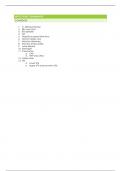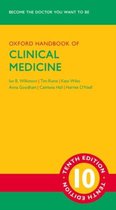INFECTIONS SUMMARIES
CONTENTS
1. C. difficile infection
2. EBV and CMV
3. Encephalitis
4. HIV
5. Hospital acquired infections
6. Human herpes virus
7. Infective diarrhoea
8. Infective endocarditis
9. Lyme disease
10. Meningitis
11. Pneumonia
a. CAP
b. HAP and other
12. Tuberculosis
13. UTIs
a. Lower UTIs
b. Upper UTIs and recurrent UTIs
,C. DIFFICILE INFECTION
TRANSMISSION AND ECOLOGY PATHOPHYSIOLOGY
Asymptomatic colonisation Important cause of diarrhoea in community and
o Toxin + strains in 3% of healthy adults healthcare infection
o Toxin -ve strains in 3% “” Spore forming anaerobic bacterium
o Infants 70% Toxigenic and non-toxigenic strains
20-40% of hospital inpatients are colonised Widespread in nature and environment – water,
Spores persist soil, animal dung
Faecal-oral acquisition from hands, Normal bowel flora in infants
environment, equipment, and other patients
Survives for long periods in the environment as spores –
patient area = heavily contaminated
Normal bowel flora is disturbed by a normal course of
abx in a patient who has ingested a strain of C. difficile
In the GI tract in the presence of bile acid, the spores
germinate to produce 2 important toxins (A+B). These
damage the colonic epithelial cells and stimulate the
CLINICAL SIGNS release of pro-inflammatory cytokines and chemokines
Large spectrum of disease leading to an intense cellular response
Colonisation of the large bowel The alteration to bowel flora lasts for a long time after
Self-limiting diarrhoea course of abx – leaving patient at risk of infection for
Severe/prolonged/relapsing diarrhoea months
Pseudomembranous colitis
Toxic megacolon, bowel perforation, life-
threatening sepsis
Death RISK FACTORS
Antibiotics
o Cephalosporins
o Ciprofloxacin
o Clindamycin
o Co-amoxiclav
And pip-taz
DIAGNOSIS Immunosuppression
Only test stool if patient is symptomatic (3 stools PPIs
grade 5-7 in 24 hours) Laxatives
GDH screening test Age
Toxin stool test Prolonged hospital stay
GI surgery
Comorbidities
Enteral feeding
MANAGEMENT
Severity assessment: temp > 38.5, PMC/colitis/toxic megacolon/ileus, WBC > 15 x 10 9, creatinine > 1.5 baseline
No markers
1st episode: oral metronidazole
1st relapse: vancomycin or fidaxomicin
2nd relapse: vancomycin plus vanc taper 6 weeks, or fidaxomicin, faecal transplant
1 marker
1st episode: oral vancomycin (125mg QDS)
1st relapse: oral fidaxomicin or vancomycin
2nd relapse vancomycin plus vanc taper 6 weeks or fidaxomicin
Life threatening disease
Oral/NG vancomycin 500mg QDS + IV metronidazole
Consider vancomycin enema
, EBV AND CMV
PATHOPHYSIOLOGY - EBV
~90% of adults have the virus which is transmitted in saliva (and possibly genital secretions)
Latency is established in resting memory B lymphocytes
Primary infection most often acquired in childhood – asymptomatic. Gives rise to infectious mononucleosis in up
to ¼ individuals when infection is delayed into adolescence
Rare but serious complications of IM: airway obstruction, splenic rupture, neurological complications (aseptic
meningitis, encephalitis, GBS)
It is an oncovirus – can drive uncontrolled B cell proliferation – link between EBV and variety of
epithelial/lymphoid tumours
No antiviral drug or EBV vaccine
CLINICAL FEATURES
Classic triad: sore throat, cervical lymphadenopathy and intermittent fever, often accompanied by malaise,
headache, sweating, GI discomfort, fatigue and poor concentration (can last for a while and present
considerable challenges)
Usually mild and unrecognised in childhood
Incubation 30-50 days
Atypical mononucleosis is seen in blood and biochemical hepatitis may be observed
A faint maculopapular rash may become apparent
EBV-associated diseases
Infectious mononucleosis
Oral hairy leukoplakia
Nasopharangeal carcinoma
African (endemic) Burkitt’s lymphoma
Immunoblastic lymphoma
Hodgkin’s lymphoma
Anaplastic gastric carcinoma
T/NK cell lymphoma
PATHOPHYSIOLOGY – CMV
Around 60% individuals at age 40 have acquired CMV, most by 60 years. Incubation period 4-6 weeks
It replicates in vivo in epithelial cells in: salivary glands, kidney, respiratory tract, other epithelial/endothelial sites.
Bone marrow progenitor cells may be prime site of latency
No vaccine
Aciclovir is not effective, alternative agents are ganciclovir, foscarnet and cidofovir (all have serious AEs) which
can be used in immunocompromised patients.
Reactivation is common and virus shed in body secretions such as urine, saliva, semen, breast milk and cervical
fluid.
Maternal infection may result in intra-uterine foetal infection and lead to foetal disease during primary infection.
CMV causes damage to target cells once they have been formed rather than being teratogenic.
Perinatal infection can occur from infection maternal genital tract secretions or breast feeding.
Postnatal infection can occur in various ways. Mononucleosis syndrome reminiscent of primary EBV infection
sometimes seen causing fever, hepatitis and atypical lymphocytosis, but pharyngitis and lymphadenopathy are
unusual.
Recurrent infections may follow reactivation of latent virus, or re-infection with another strain
Congenital CMV infection: occurs in 3/1000 live births – most common viral cause of congenital infection. 90%
are asymptomatic at birth but some show symptoms in childhood such as sensorineural deafness and intellectual
impairment
10% are symptomatic and have cytomegalic inclusion disease: inter-uterine growth retardation,
hepatosplenomegaly, hepatitis, thrombocytopenia, CNS involvement (microcephaly, encephalitis,
chorioretinitis), and other organ involvement (myocarditis, pneumonitis)
CMV in immunocompromised host: complications include pneumonitis, encephalitis – needs to be managed
with antivirals.





